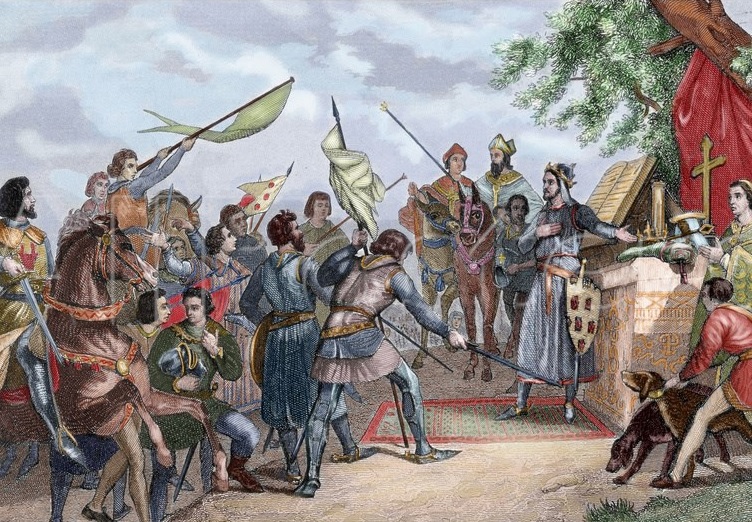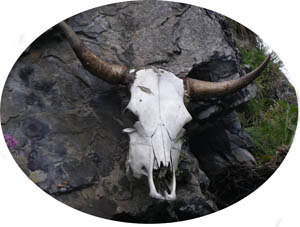How a Spanish Peasant Earned a Coat of Arms
The story behind the unusual appellative, Cabeza de Vaca (Cow’s Head), which decorates the coat of arms of the illustrious Cabeza de Vaca family is quite interesting. The name was earned by a simple local shepherd who offered his service to King Alfonso VIII during an important battle that was the turning point in the Reconquista in the 13th century.The Battle of Las Navas de Tolosa took place on July 16, 1212. The Catholic victory removed the danger of a Muslim invasion of the Catholic kingdoms and contributed to the ruin of the Almohad Empire.
At this time, the Catholics were still reeling from the defeat they had suffered from the Almohads at Alarcos in 1195. In response to a new Muslim threat from the Caliph al-Nasir, King Alfonso VIII of Castile made peace with his rivals, Sancho VII of Navarre and Peter II of Aragon, to join forces for a major offensive against the Muslims. Shortly, King Afonso II of Portugal added a contingent to that growing army.
Thus united, a major campaign was declared against the infidel, soon formally elevated to the status of Crusade by Innocent III, who ordered religious processions to be made for its success.
Even with this united Catholic front, their forces were outnumbered by the Almohad army led by Caliph al-Nasir, who also had the strategic advantage of holding a passage on the downward slope of a ridge in the Sierra Morena. Indeed, we are told by medieval chroniclers, “it was such that a thousand men could readily defend it against the greatest army on earth.“
The Catholics were at an impasse. They could neither hold their present place at the bottom of the mountain for fear of a surprise attack nor advance because of the difficulty of the one existing pass that was well-guarded by the Muslims.

Alfonso VIII at the camp Mass before the day of battle; below, King Sancho of Navarre breaks through the bodyguard of slaves guarding the caliph

Nothing could be lost in trying and a detachment of soldiers led by Don Diego López de Haro was sent out with the aim of crossing the passage and assessing the situation. Soon a message was sent to King announcing the success of the mission: The unguarded pass, now known as the he Despeñaperros Pass, led to perfect site to meet the Moors in an attack.
As the sun rose on Monday, July the 12th, the Spanish forces, armed and ready, set out in God’s name in full array to do battle with the Almohads for the Catholic Faith. For a time the Muslims endured the attack, but after heavy loss of lives, the Sultan and his remaining army gave up and fled.
A letter describing the success of Las Navas de Tolosa to Pope Innocent III relates:
“The Saracen horsemen had numbered 185,000, as we afterward learned in a true account from certain servants of the Sultan whom we took prisoner. The foot soldiers were innumerable. On their side 100,000 armed men fell in battle, perhaps more, according to the estimates of the Saracens we later captured. Of the army of the Lord only some 20 or 30 Christians fell in our whole host – a fact not to be mentioned without the most fervent thanksgiving, and one scarcely to be believed, unless it be thought a miracle. What cause for joy and thanksgiving!
"Yet there is one cause for regret here: That so few in such a vast army went to Christ as martyrs.”
To reward the assistance of the shepherd Martin Alhaja, King Alfonso VIII knighted him and gave him and his descendants the title Cabeza de Vaca. He was awarded a coat-of-arms that included cow skulls in its design.
The archives of the Spanish Empire in Madrid preserve the heraldic record, giving this description of the Cabeza de Vaca shield, “A checkerboard shield of gold and red squares, with a blue border, with six cow heads of silver” (Un escudo Jaquelado de oro y gules, con una bordura de azur, con seix cabezas de vaca, de plata).
The family bears this surname with great pride, and among its descendents we find the illustrious name of Álvar Núñez Cabeza de Vaca, whose heroic journeys through Mexico and Texas won him great renown in the Old and New World.

Excerpts from
Crusade & Christendom: Documents from Innocent III to the Fall of Acre, 1187-1291,
University of Pennsylvania Press, 2013, pp. 89-95
Crusade & Christendom: Documents from Innocent III to the Fall of Acre, 1187-1291,
University of Pennsylvania Press, 2013, pp. 89-95
